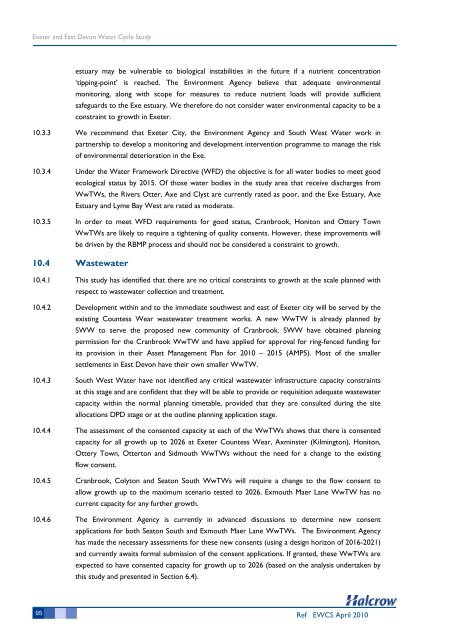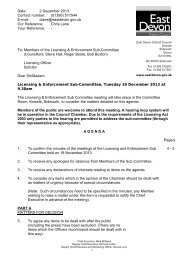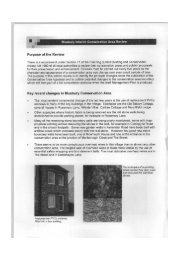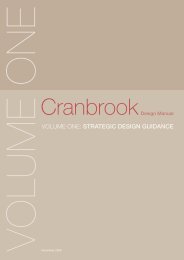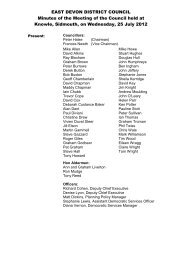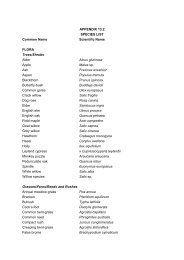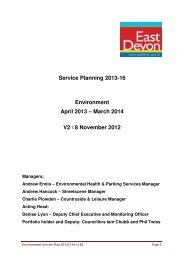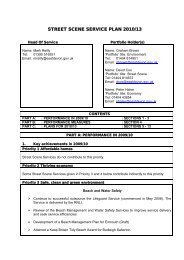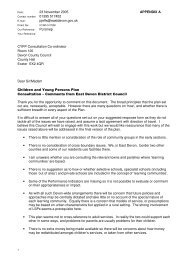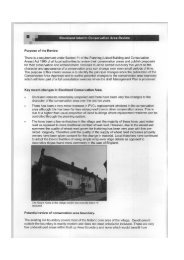Water Cycle Study - East Devon District Council
Water Cycle Study - East Devon District Council
Water Cycle Study - East Devon District Council
You also want an ePaper? Increase the reach of your titles
YUMPU automatically turns print PDFs into web optimized ePapers that Google loves.
Exeter and <strong>East</strong> <strong>Devon</strong> <strong>Water</strong> <strong>Cycle</strong> <strong>Study</strong><br />
estuary may be vulnerable to biological instabilities in the future if a nutrient concentration<br />
‘tipping-point’ is reached. The Environment Agency believe that adequate environmental<br />
monitoring, along with scope for measures to reduce nutrient loads will provide sufficient<br />
safeguards to the Exe estuary. We therefore do not consider water environmental capacity to be a<br />
constraint to growth in Exeter.<br />
10.3.3 We recommend that Exeter City, the Environment Agency and South West <strong>Water</strong> work in<br />
partnership to develop a monitoring and development intervention programme to manage the risk<br />
of environmental deterioration in the Exe.<br />
10.3.4 Under the <strong>Water</strong> Framework Directive (WFD) the objective is for all water bodies to meet good<br />
ecological status by 2015. Of those water bodies in the study area that receive discharges from<br />
WwTWs, the Rivers Otter, Axe and Clyst are currently rated as poor, and the Exe Estuary, Axe<br />
Estuary and Lyme Bay West are rated as moderate.<br />
10.3.5 In order to meet WFD requirements for good status, Cranbrook, Honiton and Ottery Town<br />
WwTWs are likely to require a tightening of quality consents. However, these improvements will<br />
be driven by the RBMP process and should not be considered a constraint to growth.<br />
10.4 Wastewater<br />
10.4.1 This study has identified that there are no critical constraints to growth at the scale planned with<br />
respect to wastewater collection and treatment.<br />
10.4.2 Development within and to the immediate southwest and east of Exeter city will be served by the<br />
existing Countess Wear wastewater treatment works. A new WwTW is already planned by<br />
SWW to serve the proposed new community of Cranbrook. SWW have obtained planning<br />
permission for the Cranbrook WwTW and have applied for approval for ring-fenced funding for<br />
its provision in their Asset Management Plan for 2010 – 2015 (AMP5). Most of the smaller<br />
settlements in <strong>East</strong> <strong>Devon</strong> have their own smaller WwTW.<br />
10.4.3 South West <strong>Water</strong> have not identified any critical wastewater infrastructure capacity constraints<br />
at this stage and are confident that they will be able to provide or requisition adequate wastewater<br />
capacity within the normal planning timetable, provided that they are consulted during the site<br />
allocations DPD stage or at the outline planning application stage.<br />
10.4.4 The assessment of the consented capacity at each of the WwTWs shows that there is consented<br />
capacity for all growth up to 2026 at Exeter Countess Wear, Axminster (Kilmington), Honiton,<br />
Ottery Town, Otterton and Sidmouth WwTWs without the need for a change to the existing<br />
flow consent.<br />
10.4.5 Cranbrook, Colyton and Seaton South WwTWs will require a change to the flow consent to<br />
allow growth up to the maximum scenario tested to 2026. Exmouth Maer Lane WwTW has no<br />
current capacity for any further growth.<br />
10.4.6 The Environment Agency is currently in advanced discussions to determine new consent<br />
applications for both Seaton South and Exmouth Maer Lane WwTWs. The Environment Agency<br />
has made the necessary assessments for these new consents (using a design horizon of 2016-2021)<br />
and currently awaits formal submission of the consent applications. If granted, these WwTWs are<br />
expected to have consented capacity for growth up to 2026 (based on the analysis undertaken by<br />
this study and presented in Section 6.4).<br />
95 Ref EWCS April 2010


